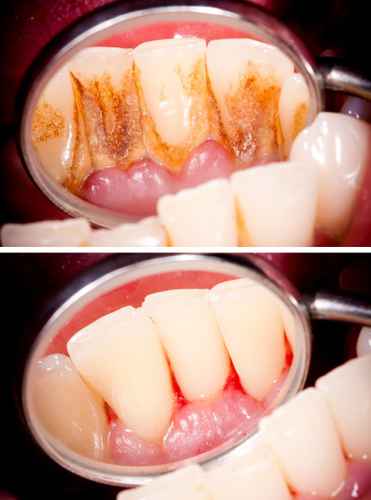Let’s quickly look at what really causes cavities to begin. Well, once both the enamel, the outer coating of the tooth, and the inner dentin layer of the tooth are affected, and the overall tooth make-up is damaged, that is usually known as a cavity, or caries, or tooth decay. When foods containing carbohydrates like sugars and starches, such as breads, fruits, cakes, cereals, milk, soda or candy, are left on the teeth, deterioration of the tooth begins to occur. Micro-organisms that make a living in the mouth process these foodstuffs, transforming them into acids. Food debris, bacteria, acid, and saliva combine to result in plaque, which sticks to the teeth. The acids formed in plaque melt the enamel exterior of the teeth, forming holes in the teeth (cavities or caries).
The Power of Brushing
Grasping some brushing techniques will give you the edge to defend your beautiful teeth from invading plaque. Pick a toothbrush with gentle, round-ended bristles and a small enough head that lets you to reach all parts of your mouth and teeth. Change your toothbrush every three months or so. Always apply fluoride toothpaste when brushing. Certain fluoride toothpastes also include tartar control, which may help slow the development of the firm mineral build-up, known as tartar. Research has shown that power-driven toothbrushes with a spinning and wavering (back-and-forth) action are more effective at cleaning teeth than are regular toothbrushes, and also normal powered toothbrushes.
Gently clean all surfaces of the teeth, cheek-side as well as tongue-side, while giving special attention to the front teeth and all faces of the back teeth. Try to position the brush at an angle where the teeth meet the gums. Grip the brush firmly, and gently rock the brush back and forth using small circular movements. Do not scrub, because forceful brushing can make the gums jerk away from the teeth and can scrape your tooth enamel.
Flossing
When it comes down to serious oral hygiene, flossing plays a very important part. The flossing process gets rid of plaque and food particles stuck between your teeth and underneath the gum-line, where regular toothbrushes hardly reach. You have a responsibility to clean between your teeth at least once a day with floss. Flossing techniques can easily be demonstrated by your dentist or hygienist, but the following tips may also help:
When the floss touches the gum-line, curve it into a C-shape alongside one tooth until you feel opposition (resistance). Hold the floss against the tooth and softly rub against the side of the tooth while keeping the floss away from the gum.
Mouthwash
Swishing everyday with specific mouthwashes can boost your oral well-being, while particular rinses may prevent plaque from building up. Excessive plaque build-up can not only cause cavities, but also gum disease. Rinse solutions containing fluoride can significantly help prevent cavities because fluoride protects against tooth decay. Since mouthwashes can help you to target plaque, try to use a special type like “Listerine Cool Blue” which is also a Pre-Brush Tinting Rinse that turns high-plaque areas into bluish hue, so you can focus your brushing and flossing. Although mostly advertised to kid, this is certainly cool for adults also!
Contact a dentist or dental hygienist at Water Brook Dental in Washington DC for a dental check-up and other dental needs. Water Brook Dental has two locations in Washington DC. The Columbia Heights location is very conveniently located to Downtown DC, Northeast DC, Adams Morgan, Dupont Circle, Logan Circle, U-Street Corridor, Mount Pleasant and many other parts of Washington. The Eastern Ave NW location is conveniently located to Downtown Silver Spring, Takoma Park MD, Silver Spring MD, Colesville, and other parts of Maryland as well as Northern Virginia and other parts of Virginia.


Leave A Comment